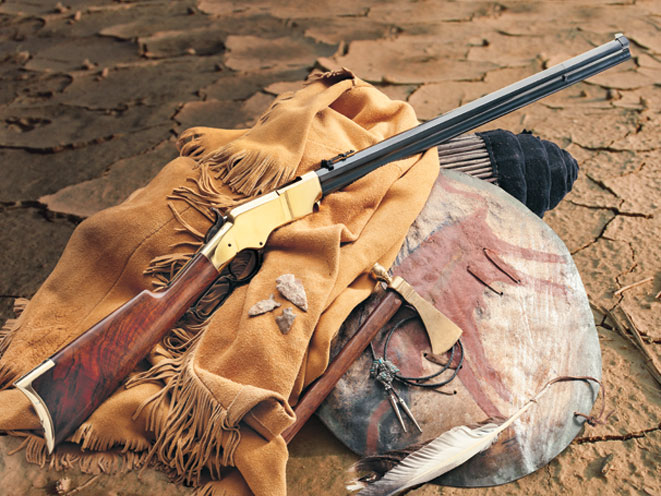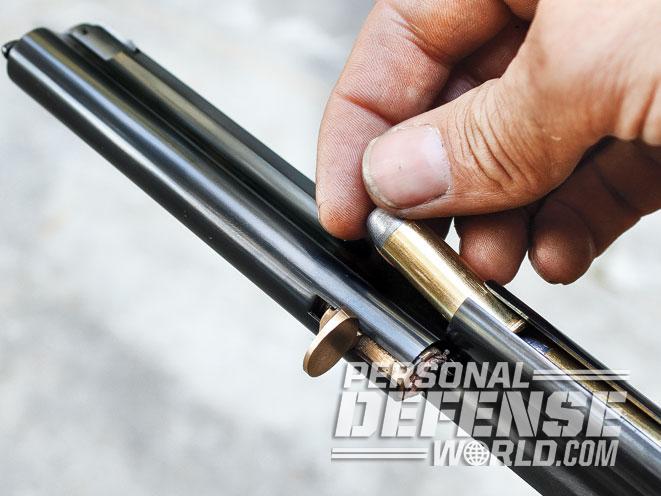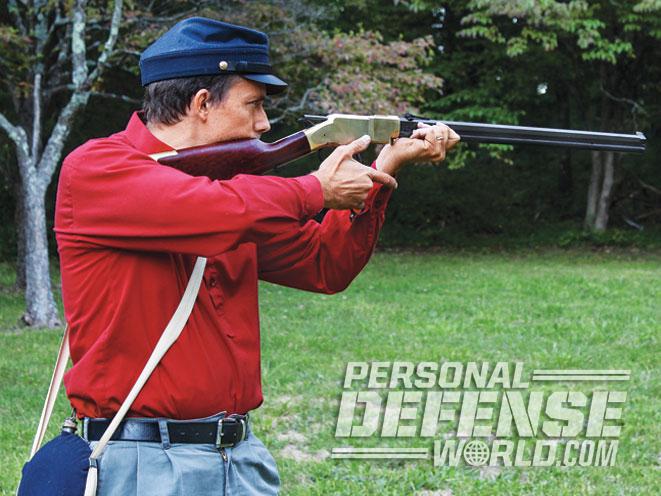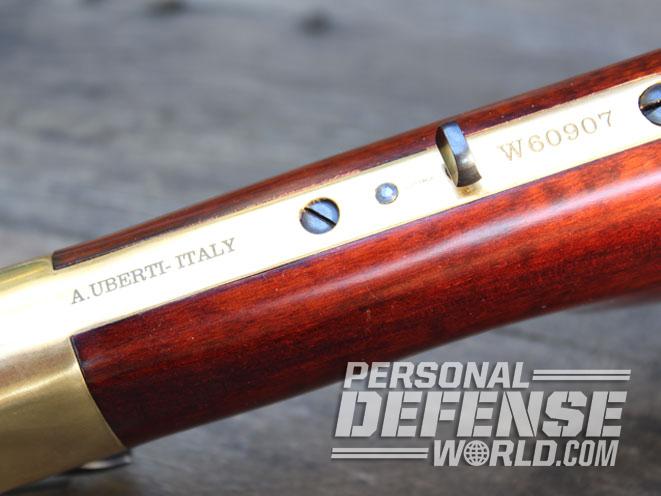Today, the profile of the lever-action 1860 Henry repeating rifle is very familiar. It’s the direct ancestor of the Winchester Model 1866 and 1873 long gun that helped tame the American West and that made the Winchester company a financial success and a household name. However, in 1862, when the Henry came on the market, single-shot muzzleloaders were the norm in America, and many viewed the Henry and its few repeating peers as just clever novelties.
Entrepreneur Oliver Winchester realized that repeating rifles were the future and invested in the new Volcanic Repeating Arms Company in 1855 and became its president in 1856. The company went bankrupt in 1857. Rather than poor management, the failure lay in the shortcomings of the product. The ingenious lever action of the Volcanic guns, which carried over into the Henry and 1866 and 1873 Winchesters, owed much to the contributions of Horace Smith and Daniel Wesson. Ingenious but impractical was the Volcanic’s peculiar, self-contained cartridge with the powder inside the hollow base of the bullet. It had many drawbacks, the most obvious being that its power was limited by the tiny amount of space available for the propellant charge.
In 1857, Oliver Winchester created and became the lead investor in the New Haven Arms Company, and in 1858 he hired Benjamin Tyler Henry to be his plant superintendent. Realizing that no repeater could succeed without an adequate self-contained cartridge, the company first developed a suitably powerful, brass-cased, .44-caliber rimfire cartridge and then redesigned the Volcanic around it. Henry’s role was so important that Winchester named the new-and-improved rifle after him and patented it in 1860.
Advertisement — Continue Reading Below
Strike & Repeat

The 1860 Henry had a 15-round magazine, and two more rounds could be accommodated in the chamber and carrier for a total of 17 rounds that could be reliably fired in as many seconds. It was accurate by the standards of the day, too, thanks to it being equipped with a graduated ladder rear sight. Army tests showed it could keep 100 percent of its shots inside a 25-inch circle at 500 yards and a 48-inch circle at 1,000 yards. Bullet weights were either 200 or 216 grains over 26 to 28 grains of black powder, giving it a muzzle velocity of 1,125 fps and a muzzle energy of 568 foot-pounds. That falls between today’s .44 Special and a .44-40 WCF of the same bullet weight; but based on my tests for this story, I find the .44 Henry’s specifications a bit suspect.
Even if the Henry was at least as powerful as the Colt Army Model 1860 pistol, I wonder how much energy it had left at 200 yards, much less either of the outlandish Army test ranges. In any case, what it lacked in power it made up for in firepower, and Oliver Winchester had high hopes of marketing the Henry to the Union Army.
Advertisement — Continue Reading Below
RELATED STORY: Uberti’s Silverboy Lever-Action Rifle in .22 LR
The Henry turned out to be too advanced for the hidebound leadership in the U.S. Army Ordnance Department to realize it merits and only 1,731 were purchased by the federal government for $63,943, or about $50 each. Another 8,732 were bought by individuals and state regiments like the 66th and 7th Illinois and the 97th Indiana.
Though military sales were disappointing, combat reports of the Henry’s performance were glowing. The Henry could lay down an unprecedented volume of fire and Confederate soldiers that faced it in battle called it “that darn Yankee rifle that they load on Sunday and shoot all week.”
Advertisement — Continue Reading Below
Compared to the standard rifle-musket of the era, the .44 Henry was a pipsqueak and the rifle lacked a bayonet. Those factors alone probably ensured it would never be selected for general issue to troops. Henry production ceased in 1866 with a total run of about 14,000 rifles. After the Civil War, Winchester and Henry had a falling out. Oliver Winchester formed Winchester Repeating Arms Company and hired Nelson King as his superintendent with the task of improving the Henry rifle. The substitution of a side loading gate, known as the “King’s Improvement,” turned the Henry into the 1866 Winchester “Yellow Boy,” which marked the beginning of Oliver Winchester’s real commercial success as an arms maker.
Standout Replica

The Uberti 1860 Henry replica I tested was beautifully made with a dark blued finish on the barrel and trigger, a case hardened lever and hammer, and a brightly polished brass frame and buttplate. The latter had a functioning trap that would have originally contained a four-piece cleaning rod. The straight-grained walnut buttstock was attractively finished and sealed but not overdone. You couldn’t see the texture of the grain, but it still looked like wood.
Advertisement — Continue Reading Below
The Uberti rifle has the pointy crescent buttplate and lever hook of later production rifles that saw service in the Civil War and that can be had with sling swivels mounted on the left side of barrel and buttstock for an additional charge. The fit of all the rifle’s parts was excellent.
RELATED STORY: Gun Review – Uberti 1873 Cattleman .22 LR
The Henry’s barrel and magazine tube are milled out of a single bar of steel, making it a heavy rifle. The replica weighs in at 9 pounds, about 1.75 pounds heavier than a comparably barreled Winchester 1873.
Advertisement — Continue Reading Below
The Henry’s unique magazine is in the usual spot under the barrel but it loads from the front. This is done by pulling the brass finger of the magazine follower all the way forward against spring pressure until it clears the rear of the 5-inch sleeve on the front of the barrel. When you push the follower all the way up, it pushes out the sleeve latch on the very tip of the sleeve tube and allows the front of the barrel to rotate to the right. It is a clever, if unnecessarily complicated, design.
Rimfire Roots

The bottom of the magazine has an open slot, which makes it easy to see how many cartridges you have left. In fact, since the follower moves closer to your hand every time you load a round, when it touches you, it acts like a warning indicator signaling that you are running low on ammo. In battle, the downside of this open slot is it could easily get fouled with dirt.
Advertisement — Continue Reading Below
RELATED STORY: 6 Manufacturers Selling Lever-Action Rifles For Home Defense Or Hunting
During loading, Uberti recommends you don’t drop the cartridges down the magazine tube and to never allow the follower to slam down on them. The company also won’t warranty the rifle if you shoot handloads in it. All this hand wringing is due the fact that the Henry was originally a rimfire. You could see how even with a flat-point bullet, a high primer in one of your reloads could be detonated if it was slammed by the follower.
The instructions also point out that you should work the lever with all four of your fingers inside to avoid hitting the trigger while cycling the action. I have never seen anyone do this, but Uberti makes a good point and I can see how it might be possible to discharge a round out of battery if you hit the trigger while working cartridges through the action to empty the magazine. It’s certainly food for thought.
Advertisement — Continue Reading Below
Range Report

On the range, I found the Uberti 1860 Henry had the smoothest action out of the box I have ever encountered on a lever gun. Loading and unloading was flawless with no damage to the fragile .44-40 case mouths on ejection. I chose .44-40 WCF hoping to get ballistic performance similar the original caliber. The authentic Patridge rear sight and stainless steel front sight gave a great sight picture. The trigger was excellent and broke cleanly with around 6 pounds of pull.
The rifle shot to point of aim at 50 yards with the ladder folded down over the barrel. At 100 yards, it shot about 6 inches below with the same sight picture. I tried using the lowest sight bar setting on the ladder but that sent the bullets clean over the target. At 100 yards, you need to use Kentucky windage with the factory sights.
Advertisement — Continue Reading Below
RELATED STORY: COMPLETE BOOK OF RIMFIRES Buyer’s Guide to Classic Rimfire Rifles
I tested lead bullet cowboy action loads from Black Hills and Winchester and found they shot almost exactly the same. The Black Hills 200-grain load was about 100 fps faster than the 225-grain Winchester round. Average five-shot group size for Black Hills was 6.4 inches at 50 yards and 11.98 inches at 100 yards. The Winchester cowboy load grouped at 6.4 inches at 50 yards and 11.58 inches at 100 yards.
I did not have the time to tailor a handload, but I had some 200-grain jacketed soft point Winchester Super-X on hand and found they shot a lot better. Average velocity of the Super-X hunting load was only 1,070 fps but the groups averaged 3.64 inches at 50 yards and 7.52 inches at 100 yards. That load produced the best groups in my test: 2.5 inches at 50 yards and 6.63 inches at 100 yards.
In every case, at 100 yards, you could clearly hear the bullet hit the target after the report from firing, and none of them matched the 1,200 fps claimed for the original blackpowder .44 Henry loading. I can’t help but think this rifle might shoot a lot better with some attentive hand loading, but as is, cowboy action shooters shouldn’t have any trouble hitting a 16-inch square rifle target out to 50 yards very quickly.
For more information, visit http://www.uberti.com or call 800-264-4962.







































